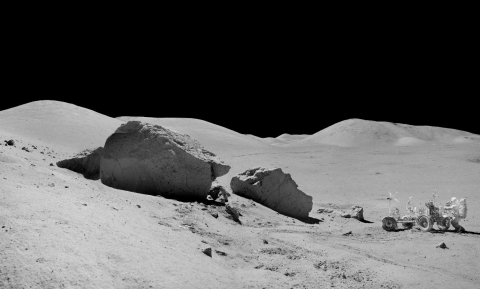

Scientists have analysed a sample collected by NASA astronauts during the Apollo 17 mission to the Moon in 1972
11 May 2020
5 min read
A team of UK scientists have contributed to research that provides new evidence that massive impact events formed large portions of the Moon’s crust.
The Moon provides a unique record of how the terrestrial planets formed and were shaped by geological processes through time. It has long been thought that magmas rising from the lunar interior were responsible for helping to build the lunar crust, whereas impacts from colliding asteroids and comets have been seen as a destructive process.
The scientists conducted new research of a sample collected by NASA astronauts during the Apollo 17 mission to the Moon in 1972. They found that it contains unique mineralogical evidence of formation at incredibly high temperatures (in excess of 2300 °C) that can only be achieved by the melting of the outer layer of a planet in a very large impact event.
The discovery reveals that unimaginably violent impact events helped to build the lunar crust, not only destroy it.
Dr James Darling, Reader in Earth and Planetary Materials
Researchers from the University of Portsmouth, The University of Manchester and The Open University, were funded by the Science and Technology Facilities Council (STFC).
The team used a technique called electron backscatter diffraction to discover the former presence of cubic zirconia, a mineral phase that would only occur in rocks heated to above 2300 °C. Radiometric age dating of the grain at the Swedish Museum of Natural History reveals that it formed over 4.3 billion years ago, indicating that large impacts were critically important to producing new rock types on the early Moon.
Dr James Darling of the University of Portsmouth said: “The discovery reveals that unimaginably violent impact events helped to build the lunar crust, not only destroy it. Going forward, it is exciting that we now have laboratory tools to help us fully understand their effects on the terrestrial planets.”
The team used a scanning electron microscope at the University of Portsmouth to diffract electrons through nanoscale volumes of the sample, making over 50,000 measurements of the internal structure of a single grain of zirconia. This revealed interlocking crystal orientations that can only be explained if the grain was once ultra-high temperature cubic zirconia.
Dr Katherine Joy of the University of Manchester said: “This study shows that we are still discovering new things about the Moon and its place in the Solar System by applying new analytical techniques to samples that were collected 48 years ago. However, we also have so many questions left to answer that will require a return to the Moon to collect new samples from completely new places and return them to our labs back here on Earth.”
Professor Mahesh Anand of The Open University added: “This study highlights the value of sample return missions and careful curation of samples for future generations of researchers. This multi-institutional collaborative research was a direct outcome of our ongoing effort to re-analyse Apollo samples using modern analytical instrumentation for addressing major science questions in planetary sciences.”
The paper led by Dr Lee White, Hatch Postdoctoral Fellow at the Royal Ontario Museum, is published today in Nature Astronomy.
An interactive image of the complex crystal analysed in the study can be viewed online using the Virtual Microscope. Resources on lunar geology for schools, museums and outreach organisers are available from the STFC Lunar Rocks and Meteorites Loan Scheme.
